Sustainability of Agritourism Activity. Initiatives and Challenges in Romanian Mountain Rural Regions
Abstract
1. Introduction
1.1. Literature Review
- The existence of a prosperous rural region, rich in natural and anthropic resources;
- People interested in practicing such an activity;
- The services offered by these people: accommodation and meals;
- The existence of a material basis (i.e., means of transport, access roads, tourist units, various leisure possibilities) and an appropriate legislative framework for carrying out this activity.
- Firstly, be developed as a complementary activity to agriculture, with the purpose of revitalizing unprofitable agricultural activities, capitalizing products from that farm through tourism activities;
- Secondly, to use all existing tourism resources from rural regions, with a focus on illustrating the specifics of rural farm life.
- Agritourism must not come as a substitute for traditional agricultural occupations; thus it is essential that the owner of the rural guesthouse/farm pursues agricultural activities;
- Because the essence of this form of tourism is rural regions and activities, the emphasis in creating a tourism product [18] must fall on activities specific to rural regions, otherwise the aim (combining tourism with agriculture) would be lost.
1.2. The Aim of the Paper
- Identification of the essence of agritourism—bringing to the foreground some key aspects of the definition and particularities of agritourism in rural regions;
- Underlining the main initiatives and challenges undertaken in the field of agritourism; in this case, multiple cases and regions where agritourism is developed, generally from the mountainous regions of Romania, have been chosen and compared;
- Identification of actions and measures specific to the local community in supporting the development of agritourism, the purpose being to capitalize on the local resources, thus supporting the future sustainable development of the community;
- Developing recommendations and relevant actions, in the form of a management plan, for a sustainable development of agritourism activity in the future.
2. Materials and Methods
2.1. Research Methods
- A first problem was the application of the 526 questionnaires, the geographical region of research being very large, which caused their application to take a long time;
- The identification of the purely agritourist structures represented a critical aspect; a clear delimitation between the agritourist structures and rural structures was necessary at the beginning of our survey.
- Identifying the characteristics of the respondents, owners of agritourism structures;
- Identifying aspects related to the knowledge of the essential characteristics of agritourism activity and the existence/non-existence of specialized training among the owners of agritourism structures;
- Identifying aspects related to the favorability of the regions for agritourism activities, through the access and tourism infrastructures, and at the same time the identification of some restrictive factors that have slowed the development of the activity so far;
- Identifying aspects related to the extent to which agritourism represented an opportunity for economic growth and development of their personal guesthouses/farms by capitalizing on the products/crafts/services in terms of the tourist product, and identifying the resources of the region/personal guesthouse that they have relied on for the carrying out the agritourism activity so far;
- Identifying aspects related to the elements that the agritourism product from the analyzed regions, must have in order to be known on the international profile market, and the actions needed to support the improvement by the local community;
- Identifying aspects related to the involvement of the local community authorities in supporting the agritourism activities in rural regions, and the willingness of the owners of the agritourism structures to cooperate with authorities and other entities, and identifying the possible actions/measures needed for the efficient development of the agritourism activity.
- For the Bran-Moeciu region, from the 383 existing agritourism guesthouses we took into consideration the 270 most representative ones. Despite the fact that not all the owners wanted to answer our questionnaire, we considered the questionnaires of the ones who answered valid, and we introduce in the study only the ones that were answered—266 structures;
- The Apuseni Mountains region has a 258 agritourism guesthouses, from which we considered 190 structures as being the most representative for our research; from these only 185 owners answered our questions;
- The Maramures region has 174 agritourism guesthouses, out of which we considered 80 as the most representative; from these we questioned 75 agritourism structures and five of them refused to provide any kind of information, leaving 70 valid questionnaires.
2.2. Research Objectives
- Identification and description of the tourist structures that capitalize the specific resources for rural environments through tourist activities.
- Presentation of some rural regions, in terms of their favorability for agritourism activities (taking into consideration the existing potential), and also identification of some aspects which the three regions still have to develop in order to make the agritourism product visible on the market.
- Determining the extent to which the agritourism activity is considered by the local owners of a guesthouse or farm as a possibility of economic growth and development.
- Identification of the elements of an agritourist product and of the directions for possible improvements in the regions subjected to analysis.
- Underling the involvement of the local community authorities in supporting the agritourism activities by identifying some possible actions/measures, and creating a possible action plan to support the efficient development of this activity.
3. Results
3.1. Agritourism in Romania—Initiatives and the Current Situation
- Regarding the number of agritourism guesthouses registered at the national level, in the analyzed period, we note an evolution in terms of their number, from 1354 registered in 2010 up to 2800 registered in 2019, the predominant share having the agritourism structures of two and three daisies/flowers (specific classification of agrotourism guesthouses fom Romania).
- The index of net use of the accommodation capacity also had an ascending development during the analyzed period, from 12.4% in 2010 to 23.2% in 2019, a possible cause being the consolidation of the agritourism image among the consumers of tourism.
3.2. Representative Agritourism Regions in Romania—Analysis and Comparisons
3.3. Identifying the Current Situation and Challenges of Agritourism Activity in the Regions Taken under Study
3.3.1. Identifying the Characteristics of the Respondents (Owners of Agritourism Structures)
3.3.2. Identifying Aspects Related to the Knowledge of Agritourism Activity’s Essential Characteristics and the Existence/Non-Existence of Specialized Training among the Owners of Agritourism Structures
3.3.3. Identifying Aspects Related to the Extent to which Agritourism Represents a Chance of Economic Growth and Development of own Guesthouse/Farm by Capitalizing the Products/Crafts/Services through the Tourist Product and the Identification of the Resources of the Region/Guesthouse to Rely on In Case of Agritourism Activity
- In the Bran-Moeciu region, the owners of agritourism structures have relied on developing activity based on the unique resources relevant to the location, and on activities specific to the life on an agricultural farm;
- In the Apuseni Mountains region, the existence of numerous unique resources, as well as the numerous traditions/customs/crafts, are the main strengths on the basis of which the majority of agritourism structures are built;
- The Maramures region’s representative elements for agritourism are numerous traditions, numerous rural resources (see Figure 9), some known on international level, and moreover well-preserved gastronomic elements—these aspects being highlighted from the responses of interviewed owners of agritourism structures.
3.3.4. Identifying Elements that Agritourist Product Must Have In Order to Be Known on the International Profile Market, and the Role of the Local Community in Supporting the Improvement Directions of Tourist Products, so as to Ensure the Sustainable Development of the Local Community
- A total of 461 out of the 526 owners questioned, i.e., 87.63%, consider that the return to nature and active relaxation (1) would be the element that the agritourist product from the three regions under study should rely on in order to be known on the international profile market, and within the regions analyzed, the owners from Bran-Moeciu region put this aspect first;
- A total of 389 out of the 526 owners questioned, i.e., 73.94%, believe that the focus should be on healthy food/products (2) so that the Romanian agritourist product would be known internationally, and within the regions analyzed, the owners from Apuseni Mountains region were the ones who put this aspect first;
- A total of 327 out of the 526 owners questioned, i.e., 62.15%, believe that the participation in the life of the rural community (3) would be the element needed by the Romanian agritourist product in order to make itself known, and a large proportion of those from the Maramures region relied on this aspect.
- An increase of the quality of the tourist experience by improving the accommodation (a) was chosen by respondents from the Bran-Moeciu and Apuseni regions;
- A focus on the agritourism activities used to attract tourists (b) is the main element possible to be sustained by the local community in order to improve the tourist product chosen by respondents from the Bran-Moeciu region and from the Apuseni Mountains;
- The introduction of local gastronomic products (c) is the direction that can be supported by the local community in order to improve the tourist product, according to respondents from the Maramures region and the Apuseni Mountains.
3.3.5. Identifying Aspects Rlated to the Involvement of the Local Community Authorities in Supporting Agritourism Activities and the Willingness of the Owners of Agritourism Structures to Cooperate with Authorities and Other Entities, in order to Identify the Possible Actions/Measures for Efficient Sustainable Development of Agritourism Activities
- Encourage the practice of traditional activities in the neighboring rural communities,
- Stop the land abandonment and the chaotic development of tourism activities, in deep disagreement with the representative features of the region, supporting farmers to add complementary income to their farm;
- Support the preservation of and at the same time add value to rural traditions and cultural initiatives;
- Capitalize “specific” rural products that will improve the relationship between city and countryside.
4. Discussion
5. Conclusions
- Aspects related to the knowledge of agritourism activity’s essential characteristics and the existence/non-existence of specialized training among the owners of agritourism structures;
- The favorability for agritourism activities, in terms of the access and tourism infrastructure, and at the same time the nomination of some restrictive factors;
- The extent to which agritourism represents an opportunity for economic growth and development of questionnaire respondents’ guesthouses/farms by capitalizing products/crafts/services through the tourist product, and the identification of the resources of the region/guesthouses can rely on in case of agritourism activity;
- The elements that an agritourist product needs in order to be known on the international profile market, and the role of the local community in supporting the improvement directions of the tourist product, so as to ensure the sustainable development of the local community;
- The involvement of the local community authorities in supporting agritourism activities and the willingness of the owners of agritourism structures to cooperate with authorities and other entities, in order to identify the possible actions/measures for the efficient sustainable development of agritourism activity.
Author Contributions
Funding
Acknowledgments
Conflicts of Interest
References
- Pasquilini, B.; Jacquot, B. Tourism en Europe. In Action Touristique; Dounod: Paris, France, 1992. [Google Scholar]
- Stucki, E. Le developpement équilibré du monde rurale en Europe occidentale. Sauvegarde Nat. 1992, 58, 1–64. [Google Scholar]
- Page, S.T.; Getz, D. The Business of Rural Tourism: International Perspectives; Cengage Learning EMEA: New York, NY, USA, 1997; Volume 4. [Google Scholar]
- Lane, B. Rural Tourism: An Overview: The Sage Handbook of Tourism Studies; Sage Publications Ltd.: Sauzendeaux, CA, USA, 2009; pp. 354–370. [Google Scholar]
- Wilson, S.; Fesenmaier, D.R.; Fesenmaier, J.; van Es, J.C. Factors for success in rural tourism development. J. Travel Res. 2001, 40, 132–138. [Google Scholar] [CrossRef]
- Development Committee on Tourism Secretariat. Tourism Strategies and Rural Development; OECD: Paris, France, 1994. [Google Scholar]
- Nidumolu, R.; Prahalad, C.K.; Rangaswami, M.R. Why sustainability is now the key driver of innovation. Harvard Bus. Rev. 2009, 87, 56–64. [Google Scholar]
- Ko, D.W.; Stewart, W.P. A structural equation model of residents’ attitudes for tourism development. Tour. Manag. 2002, 23, 521–530. [Google Scholar] [CrossRef]
- Muresan, I.C.; Oroian, C.F.; Harun, R.; Arion, F.H.; Porutiu, A.; Chiciudean, G.O.; Todea, A.; Lile, R. Local residents’ attitude toward sustainable rural tourism development. Sustainability 2016, 8, 100. [Google Scholar] [CrossRef]
- Kim, K.; Uysal, M.; Sirgy, J. How does tourism in a community impacts the quality of life of community ersidents? Tour. Manag. 2013, 36, 527–540. [Google Scholar] [CrossRef]
- Jauhari, V. Managing Sustainability in the Hospitality and Tourism Industry; Apple Academic Press Inc.: Oakville, ON, Canada, 2014; p. 67. [Google Scholar]
- Jenkins, I.; Schröder, R. Sustainability in Tourism; Springer Fachmedien: Wiesbaden, Germany, 2013; p. 68. [Google Scholar]
- Meadows, D. Indicators and Information Systems for Sustainable Development: A Report to the Balaton Group; Hartland Four Corners: Hartland, VT, USA, 1998. [Google Scholar]
- Middleton, A. Managing ecological balance. In Sustainability in Tourism; Springer Gabler: Wiesbaden, Germany, 2013; pp. 137–157. [Google Scholar]
- Li, B.; Mi, Z.; Zhang, Z. Willingness of the new generation of farmers to participate in rural tourism: The role of perceived impacts and sense of place. Sustainability 2020, 12, 766. [Google Scholar] [CrossRef]
- Tew, C.; Barbieri, C. The perceived benefits of agritourism: The provider’s perspective. Tour. Manag. 2012, 33, 215–224. [Google Scholar] [CrossRef]
- Lupi, C.; Giaccio, V.; Mastronardi, L.; Giannelli, A.; Scardera, A. Exploring the features of agritourism and its contribution to rural development in Italy. Land Use Policy 2017, 64, 383–390. [Google Scholar] [CrossRef]
- Murphy, P.E.; Pritchard, M.P.; Smith, B. The destination product and its impact on traveler perceptions. Tour. Manag. 2000, 21, 43–52. [Google Scholar] [CrossRef]
- Turnock, D. Sustainable rural tourism in romanian Carpatians. Geogr. J. 1999, 165, 192–199. [Google Scholar] [CrossRef]
- Cioca, L.I.; Giurea, R.; Precazzini, I.; Ragazzi, M.; Achim, M.I.; Schiavon, M.; Rada, E.C. Agro-tourism and ranking. AIP Conf. Proc. 2018, 1968, 020022. [Google Scholar] [CrossRef]
- Brezuleanu, S.; Brad, I. Consideraţii privind activităţile agroturistice din landul Baden-Wurttemberg, Germania. 2001, Volume 44. Available online: http://www.uaiasi.ro/revagrois/PDF/pdf_2001_fdf99a5620d83e128992e72b54a04713.pdf (accessed on 7 March 2019).
- Marin, D. Study on the economic impact of tourism and of agritourism on local communities. Res. J. Agric. Sci. 2015, 47, 160–163. [Google Scholar]
- Ciolac, R.; Adamov, T.; Iancu, T.; Popescu, G.; Lile, R.; Rujescu, C.; Marin, D. Agritourism-a sustainable development factor for improving the ‘health’ of rural settlements. Case study apuseni mountains area. Sustainability 2019, 11, 1467. [Google Scholar] [CrossRef]
- Tinsley, R.; Lynch, P. Small tourism business networks and destination development. Intl. J. Hosp. Manag. 2001, 20, 367–378. [Google Scholar] [CrossRef]
- Călina, A.; Călina, J.; Iancu, T. Research regarding the implementation, development and impact of Agritourism on Romania’s rural areas between 1990 and 2015. Environ. Eng. Manag. J. 2017, 16, 157–168. [Google Scholar] [CrossRef]
- Bausch, T. Le Tourisme et l’ Environnement en Europe; Office des Publications Officielles des Communautes Europeennes: Brussels, Belgium, 1995. [Google Scholar]
- Glăvan, V. Turism Rural, Agroturism, Turism Durabil, Ecoturism; Editura Economică: Bucureşti, Romania, 2003. [Google Scholar]
- Istrate, I.; Bran, F.; Roşu, G. Economia Turismului şi Mediul Înconjurator; Editura Economica: Bucureşti, Romania, 1996. [Google Scholar]
- Hall, D.; Kirkpatrick, I.; Mitchell, M. Rural Tourism and Sustainable Business; Channel View Publications: Bristol, UK, 2005. [Google Scholar]
- Font, X.; Mccabe, S. Sustainability and marketing in tourism: Its contexts, paradoxes, approaches, challenges and potential. J. Sustain. Tour. 2017, 25, 869–883. [Google Scholar] [CrossRef]
- Battaglini, L.; Corrado, F. The return to the rural mountain lands: Different aspects of an on going phenomenon. Sci. Territ. 2014, 2, 79–86. [Google Scholar]
- National Institute of Statistics. Available online: http://statistici.insse.ro (accessed on 6 May 2018).
- Abrudan, I.; Turnock, D.A. Rural development strategy for the Apuseni Mountains, Romania. GeoJournal 1998, 46, 319–336. [Google Scholar] [CrossRef]
- Bran, P.; Bran, F.; Roşca, I.; Manea, G.; David, O.; Costică, I.; Iorgulescu, A. Componenta Ecologică a Strategiei de Dezvoltare Economică a Zonei Munţilor Apuseni: Studiu de caz Roşia Montană; Editura A.S.E.: Bucureşti, Romania, 2003. [Google Scholar]
- Ciolac, R.; Rujescu, C.; Constantinescu, S.; Adamov, T.; Dragoi, M.; Lile, R. Management of a tourist village establishment in mountainous area through analysis of costs and incomes. Sustainability 2017, 9, 875. [Google Scholar] [CrossRef]
- Vaetisi, S. Rural tourism in the Apuseni Mountains, Romania. An anthropological research on using natural and cultural resources in developing tourism in a poor region. In Tourists and Tourism; Nigam, D., George, B.P., Eds.; Abhijeet Publications: New Delhi, India, 2007; ISBN-13: 978-8188683994; pp. 40–52. [Google Scholar]
- Negrusa, A.L.; Cosma, S.A.; Bota, M. Romanian rural tourism development a case study: Rural tourism in Maramures. Int. J. Bus. Res. Publ. 2007, 7, 129–135. [Google Scholar]
- MediaFax. Available online: https://www.mediafax.ro/life-inedit/cnn-lauda-peisajele-din-muntii-apuseni-cel-mai-bine-pastrat-secret-din-europa-de-est-timpul-sta-pe-loc-aici-video-18439721 (accessed on 16 March 2020).
- Han, H.; Eom, T.; Al-Ansi, A.; Ryu, H.B.; Kim, W. Community-based tourism as a sustainable direction in destination development: An empirical examination of visitor behaviors. Sustainability 2019, 11, 2864. [Google Scholar] [CrossRef]
- Richards, G.; Hall, D.T. Tourism and Sustainable Community Development; Taylor & Francis e-Library: Abingdon, UK, 2002. [Google Scholar]
- Pérez-Calderón, E.; Prieto-Ballester, J.M.; Miguel-Barrado, V.; Milanés-Montero, P. Perception of sustainability of spanish national parks: Public use, tourism and rural development. Sustainability 2020, 12, 1333. [Google Scholar] [CrossRef]
- Khan, A.; Bibi, S.; Lorenzo, A.; Lyu, J.; Babar, Z.U. Tourism and development in developing economies: A policy implication perspective. Sustainability 2020, 12, 1618. [Google Scholar] [CrossRef]
- Arion, F.; Muresan, I. An Overview of Rural Tourism in the Development Regions of Romania; Bulletin of the University of Agricultural Sciences and Veterinary Medicine Cluj-Napoca Horticulture: Cluj-Napoca, Romania, 2008; Volume 62, pp. 35–40. [Google Scholar]
- Trišić, I.; Štetić, S.; Privitera, D.; Nedelcu, A. Wine routes in vojvodina province, northern serbia: A tool for sustainable tourism development. Sustainability 2020, 12, 82. [Google Scholar] [CrossRef]
- Akbar, I.; Yang, Z.; Han, F.; Kanat, G. The influence of negative political environment on sustainable tourism: A study of aksu-jabagly world heritage site, kazakhstan. Sustainability 2020, 12, 143. [Google Scholar] [CrossRef]
- Sonnino, R. For a ‘Piece of Bread’? Interpreting sustainable development through agritourism in southern Tuscany. J. Eur. Soc. Rural Sociol. 2004, 44, 285–300. [Google Scholar] [CrossRef]
- Nemirschi, N.; Craciun, A. Entrepreneurship and tourism development in rural areas: Case of Romania. Rom. Econ. Bus. Rev. 2014, 5, 138–143. [Google Scholar]
- Euromontana. Către dezvoltarea integrată a zonelor montane și recunoașterea acestora în cadrul politicii agricole comune. Modelarea noului spațiu european. In Proceedings of the Euromontana Conference, Piatra Neamț, Romania, 4–6 October 2007. [Google Scholar]
- Comisia Europeană. O Selecție a Celor Mai Bune Practici Leader+; Comisia Europeană: Brussels, Belgium, 2009. [Google Scholar]
- RNDR. Bune Practici, 2014, 4 Anul II, USR, Departamentul Publicaţii MADR. Available online: http://madr.ro (accessed on 16 February 2019).
- Ammirato, S.; Felicetti, A. The agritourism as a means of sustainable development for rural communities: A research from the field. Int. J. Interdiscip. Environ. Stud. 2014, 8, 17–29. [Google Scholar] [CrossRef]
- Karabati, S.; Dogan, E.; Pinar, M.; Celik, M.L. Socio-economic effects of agri-tourism on local communities in turkey: The case of aglasun. Int. J. Hosp. Tour. Adm. 2009, 10, 129–142. [Google Scholar] [CrossRef]
- Andriotis, K. Local authorities in Crete and the development of tourism. J. Tour. Stud. 2002, 13, 53–62. [Google Scholar]
- Lane, B.; Kastenholz, E. Rural tourism: The evolution of practice and research approaches–Towards a new generation concept? J. Sustain. Tour. 2015, 23, 1133–1156. [Google Scholar] [CrossRef]
- Stetic, S. Specific features of rural tourism destinations management. J. Settl. Spat. Plan. Spec. Issue 2012, 1, 131–137. [Google Scholar]
- Nunkoo, R.; Ramkissoon, H. Developing a community support model for tourism. Ann. Tour. Res. 2011, 38, 964–988. [Google Scholar] [CrossRef]
- Feyers, S.; Stein, T.; Klizentyte, K. Bridging worlds: Utilizing a multi-stakeholder framework to create extension–tourism partnerships. Sustainability 2020, 12, 80. [Google Scholar] [CrossRef]
- Lo, M.C.; Ramayah, T.; Hui, H.L.H. Rural communities perceptions and attitudes towards environment tourism development. J. Sustain. Dev. 2014, 7, 84–94. [Google Scholar] [CrossRef]
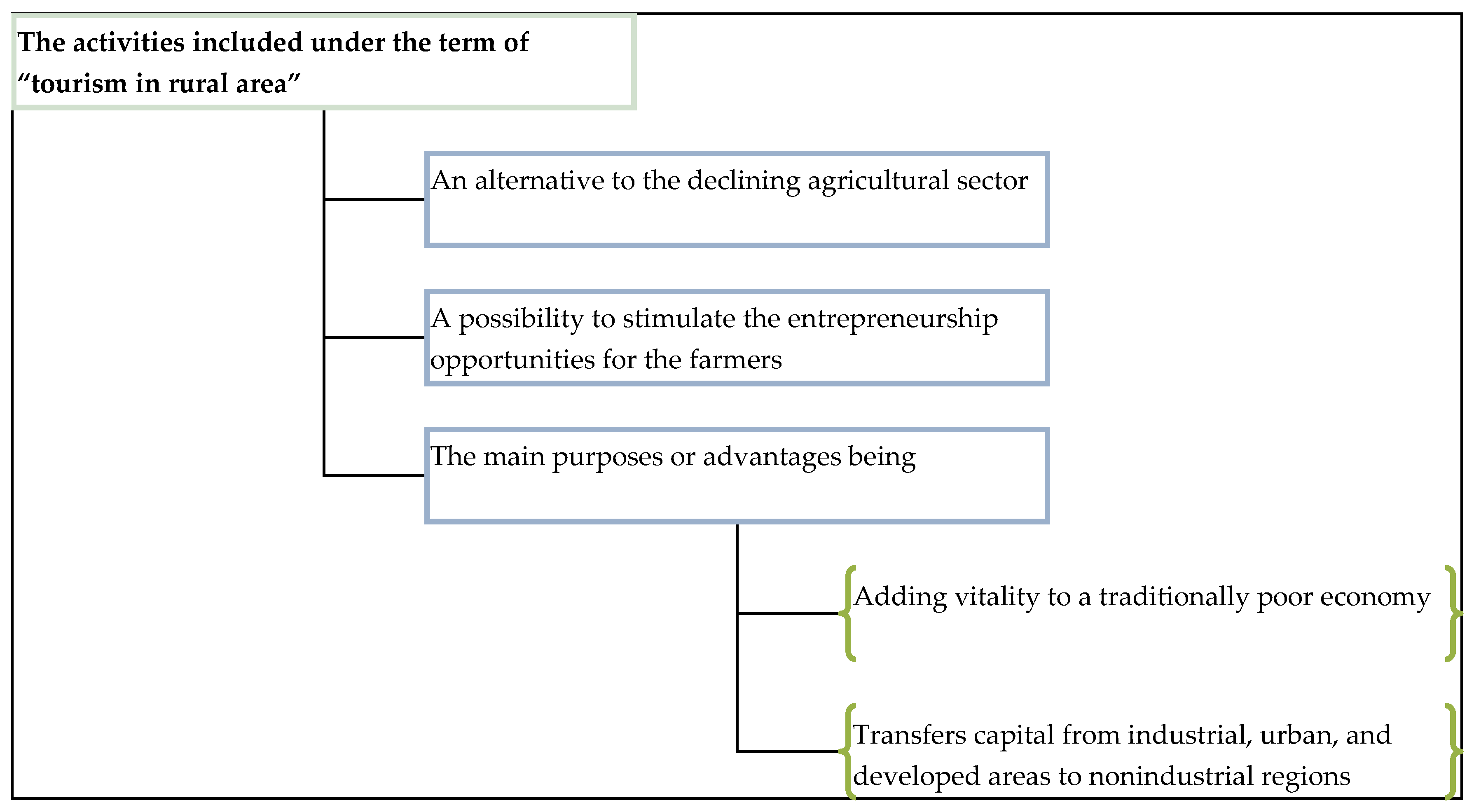
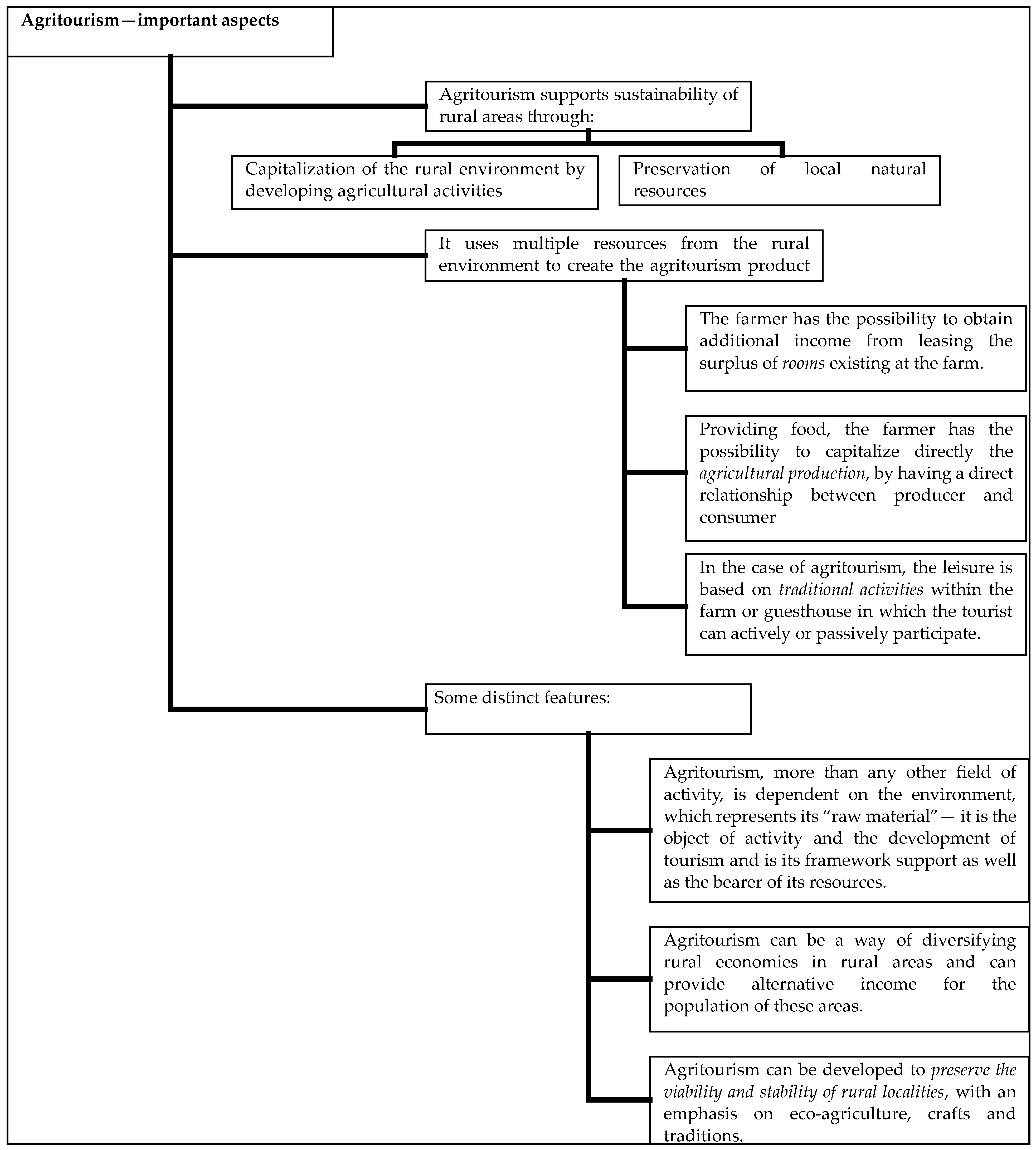
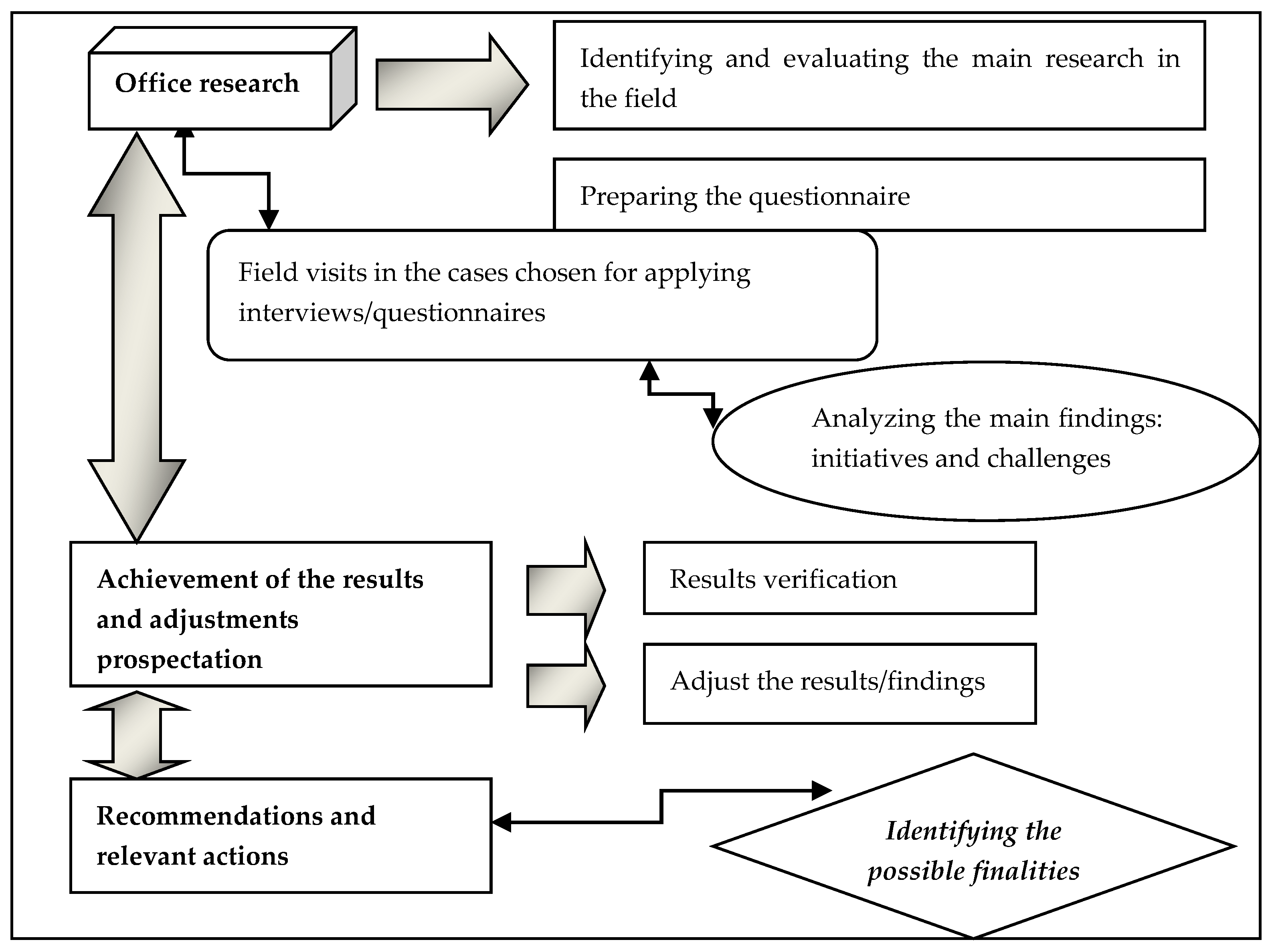
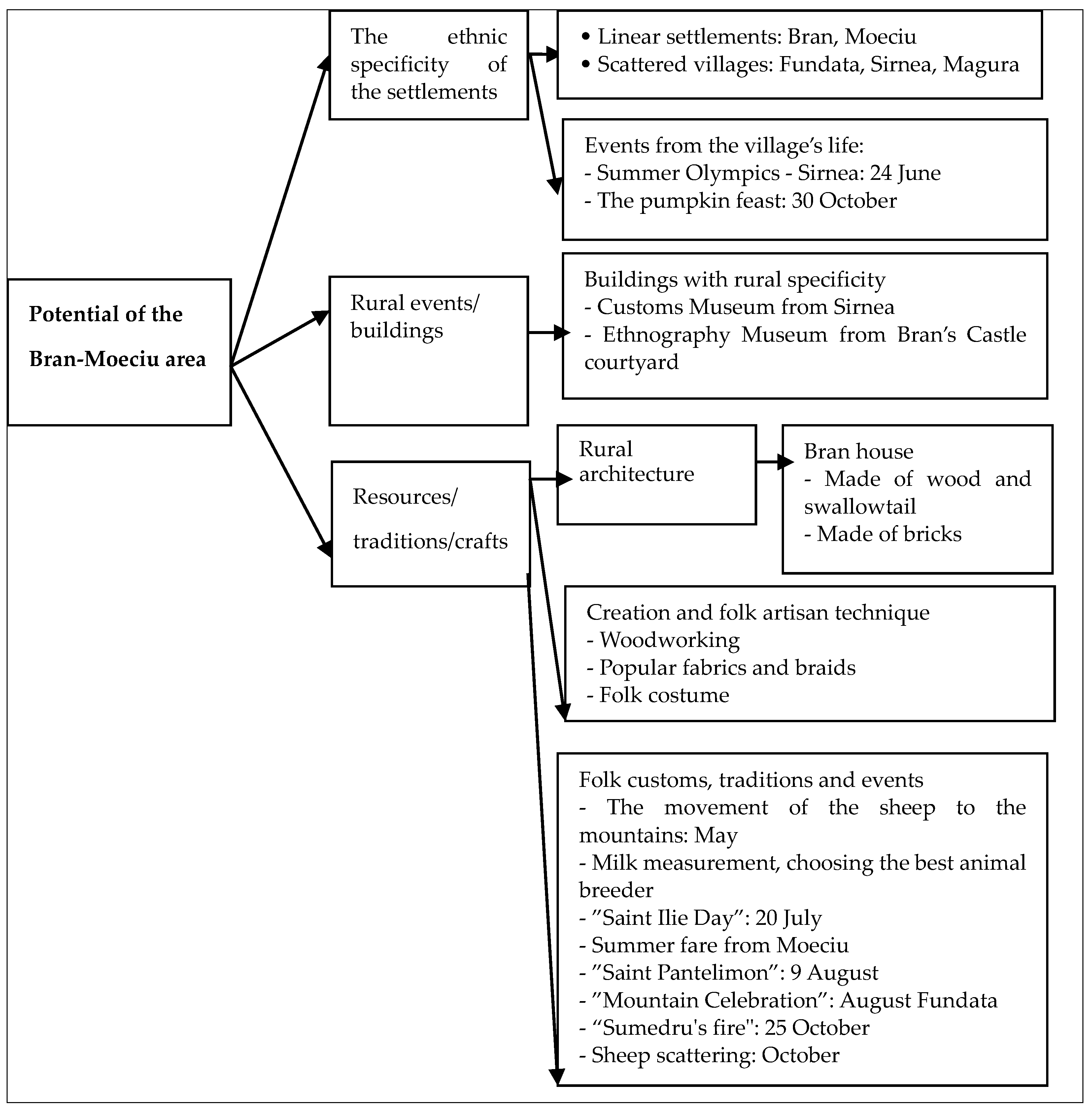
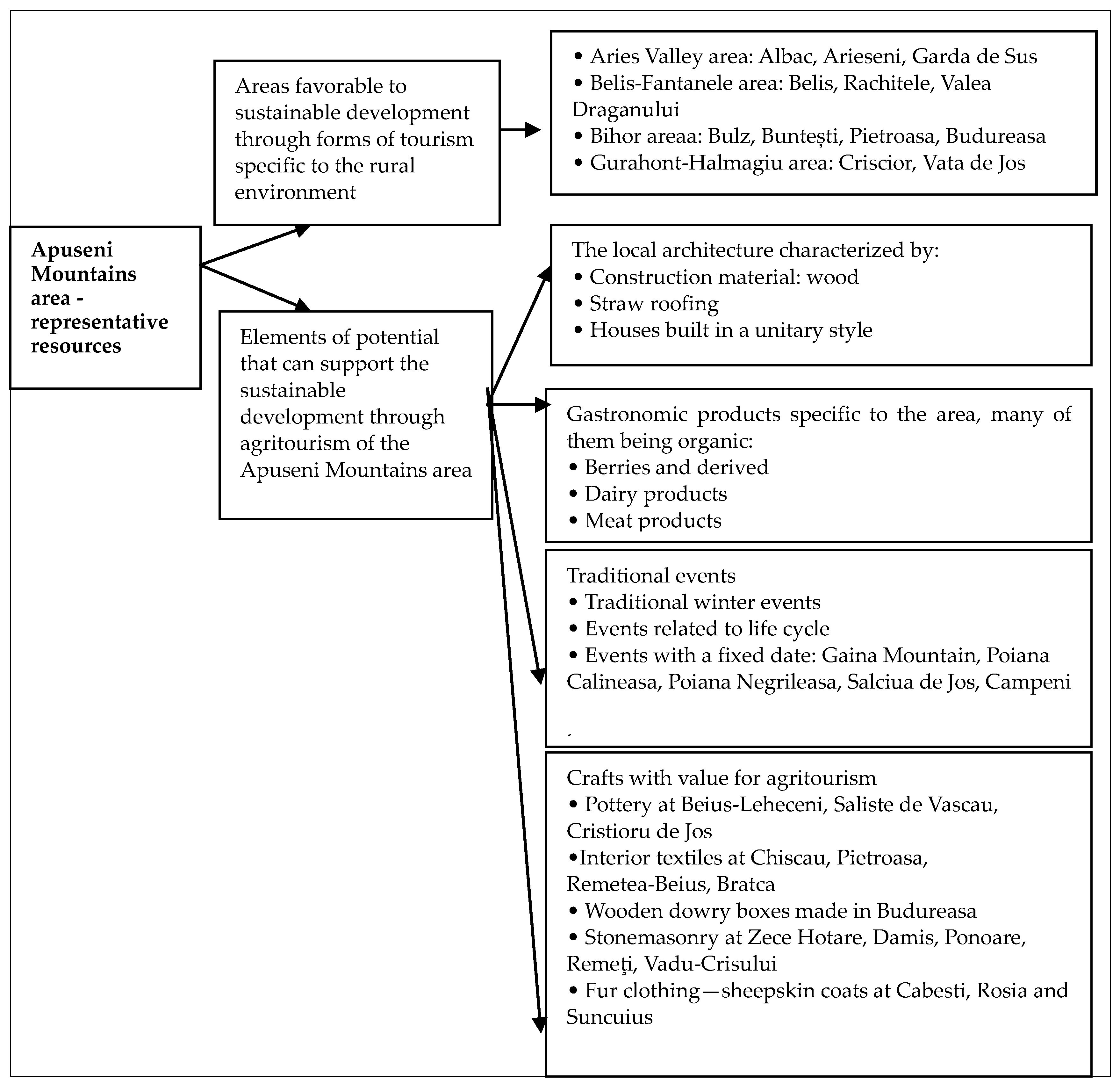
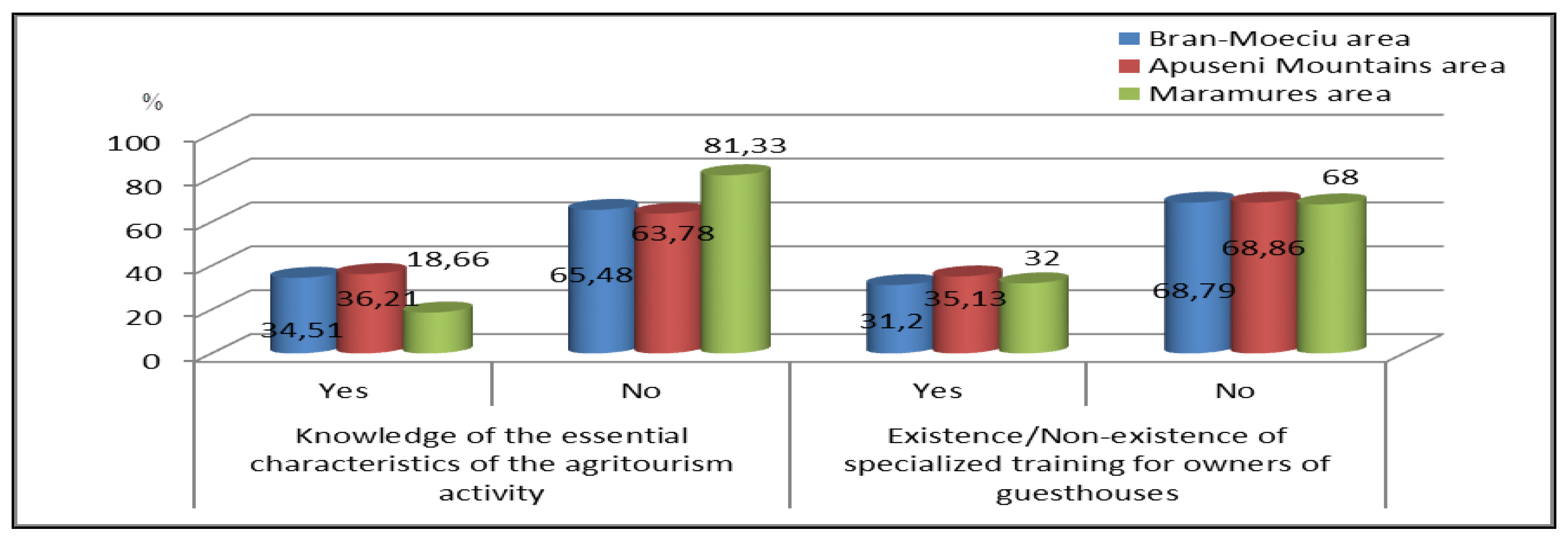
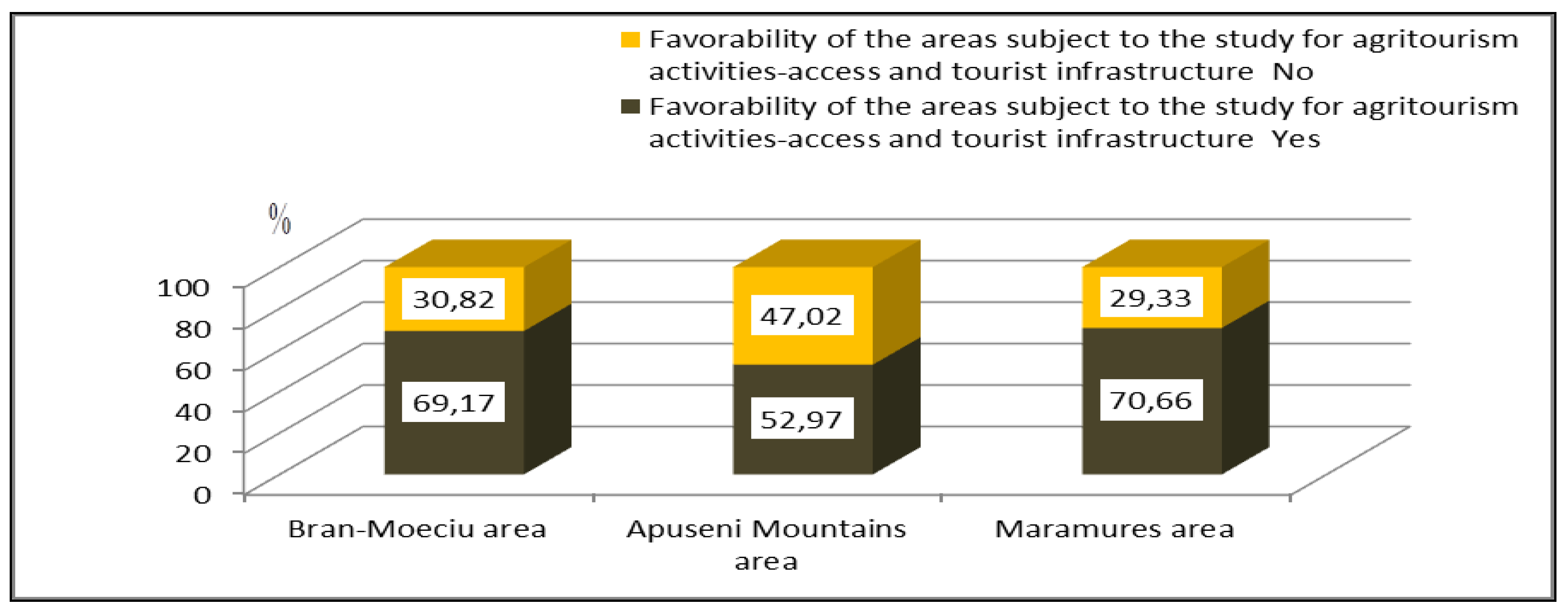
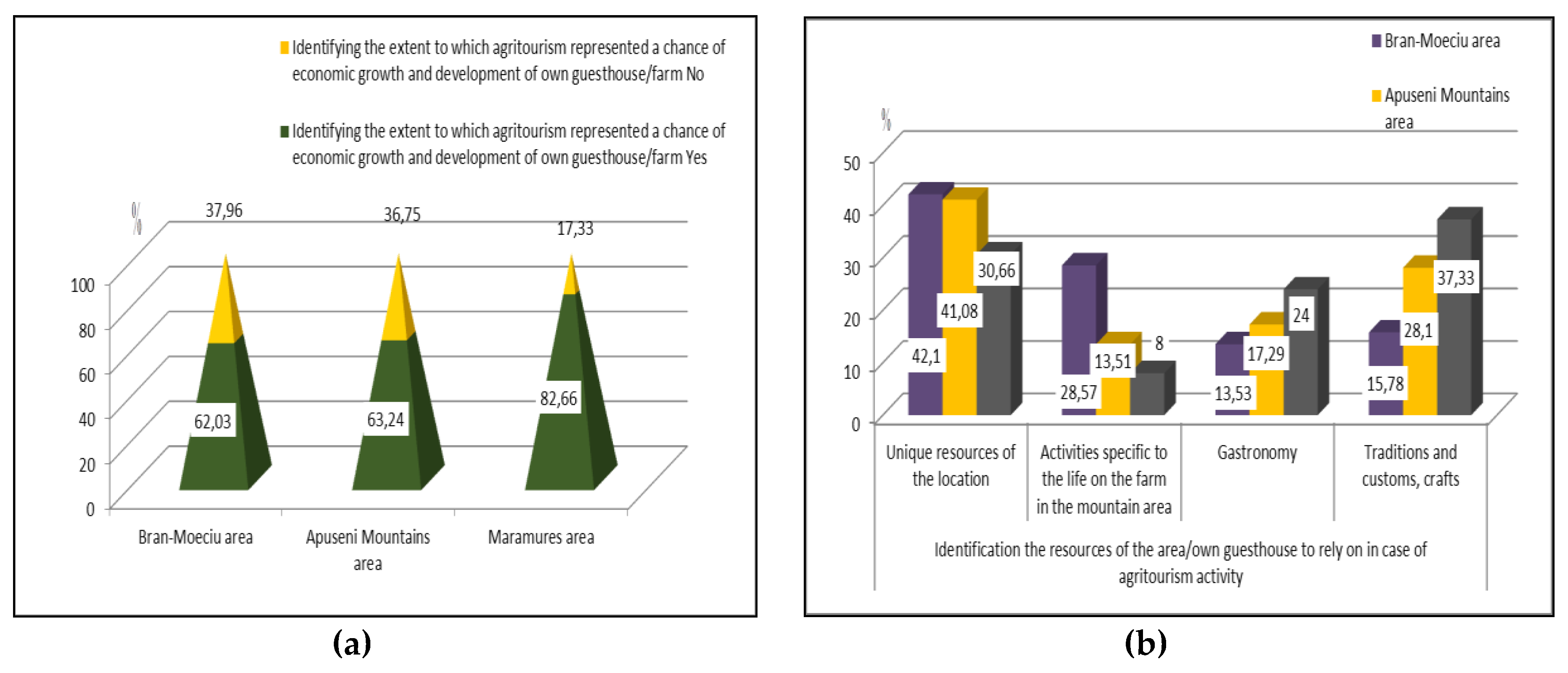
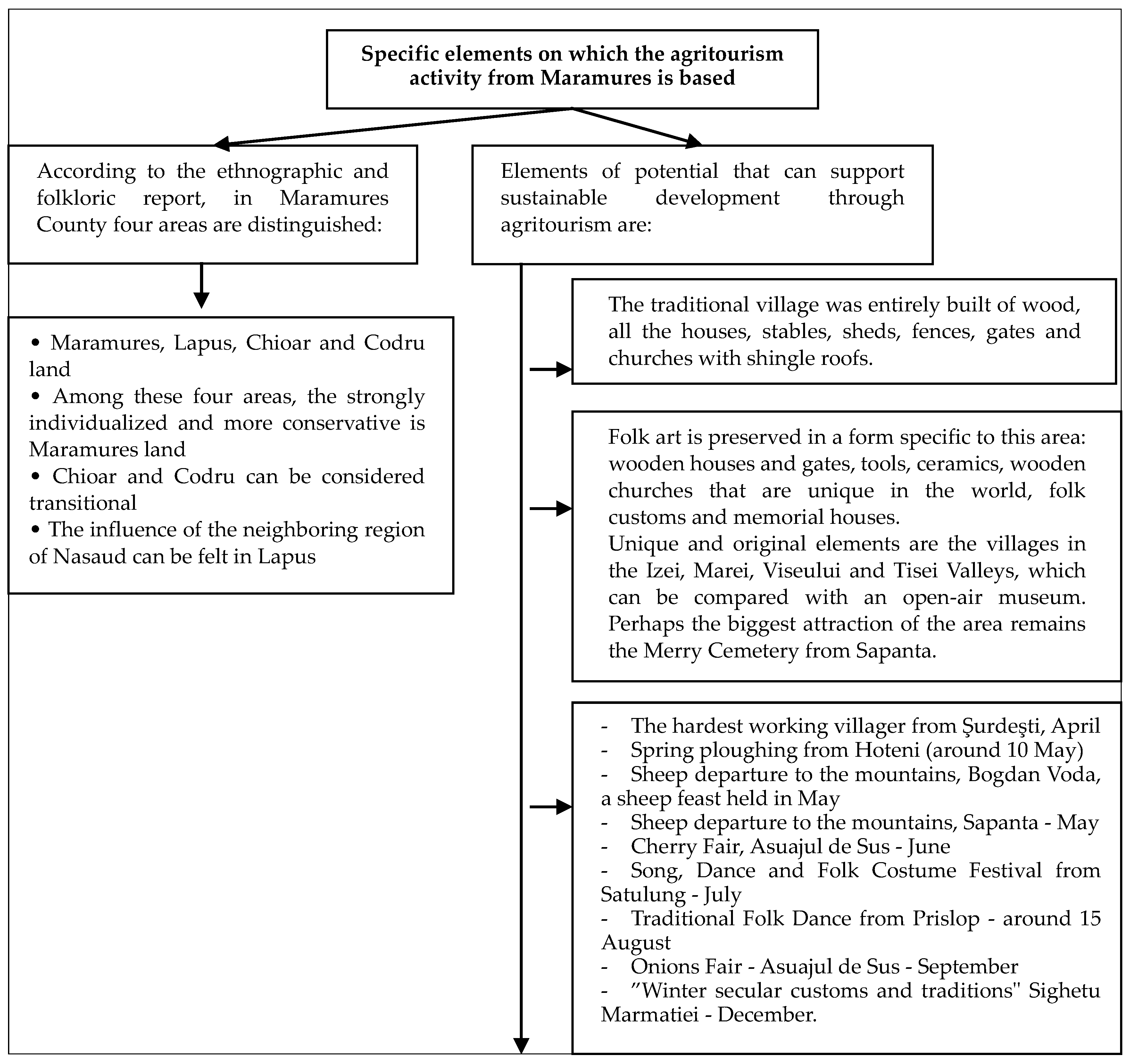
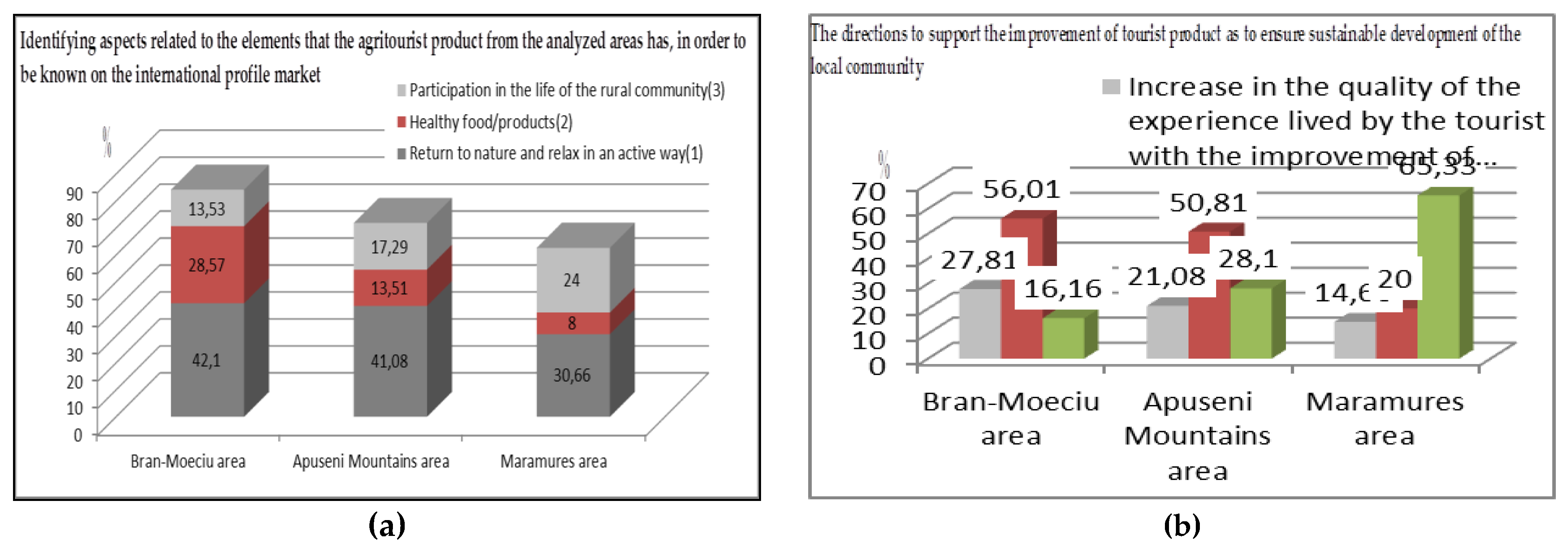
| Criteria Taken into Consideration for Defining Agritourism | The Key Aspects of the Definition | Benefits from Agritourism Activities |
|---|---|---|
| Defining agritourism from the perspective of tourist reception structures | Capitalization of the surplus of the accommodation spaces existing in a guesthouse— | Benefits for communities
Benefits for the tourism industry
Advantages for farmers
|
| these spaces must be arranged and prepared for the reception of the tourists | ||
| Defining agritourism from the perspective of activities | A set of goods and services offered to tourists by the guesthouse for consumption | |
| through direct involvement, active but non-remunerated | ||
| Defining agritourism from the perspective of the local economy | A source of achieving and increasing the local income |
| Steps for Romanian Agritourism Development | Actions | Consequences/Benefits |
|---|---|---|
| The first attempts of organized tourism were made in 1967–1968. | A series of measures have been taken in order to ensure the accommodation and thus the fluidization of the Romanian Black Sea coast. | It was a promising start. |
| In 1972, the Ministry of Tourism elaborated Order 297/1972. | The Research Center for the Promotion of International Tourism continues identifying and selecting representative rural localities appropriate for rural tourism activity. | It has been established that about 118 rural localities can serve domestic and international tourism. |
| On July 16th, 1973 the Order of the Ministry of Tourism number 744/1973 was issued. | Experimentally, 14 localities were declared villages of tourist interest, called “tourist villages”: Leresti (Arges County), Fundata Sirmea (Brasov), Sibiel (Sibiu), Tismana (Gorj County), Murighiol and Crisan (Tulcea), Racos (Timis County), Sfantu Gheorghe (Tulcea), Bogdan Voda (Maramures County), Vatra Moldovitei (Suceava County), Poiana salted water (Bacau), and Valcea (Vaideeni) [27]. | The introduction of the possibility of rural environment capitalization through tourist activities. |
| Through the Decree 225/1974 accommodation of foreign tourists in private homes was forbidden. | Tourist villages become non-functional for external tourism. In many localities, guesthouses met the conditions of accommodation (Rucar, Vatra Moldovitei, Vaideeni) but it was forbidden to accommodate foreign tourists. With very small exceptions, this situation lasted until 1989. | The short period of the “formalization” of rural tourism did not make possible the organization of the activity or the proper arrangement of the tourist villages. |
| The period of 1989 and after | Support for the proper development of agritourism activity:
| Agritourism has become a certainty in Romania as it presents itself as a complex and well-articulated activity. |
| Specification | 2010 | 2011 | 2012 | 2013 | 2014 | 2015 | 2016 | 2017 | 2018 | 2019 |
|---|---|---|---|---|---|---|---|---|---|---|
| No. of agritourism guesthouses | 1354 | 1210 | 1569 | 1598 | 1665 | 1918 | 2028 | 2556 | 2821 | 2800 |
| Index of net use of agritourism accommodation capacity (%) | 12.4 | 13.8 | 13.2 | 12.6 | 13.2 | 15.1 | 15.5 | 15.7 | 18.9 | 23.2 |
| Agritourism in the Bran-Moeciu region—current situation | ||||||||||
| Specification | 2010 | 2011 | 2012 | 2013 | 2014 | 2015 | 2016 | 2017 | 2018 | 2019 |
| No. of agritourism guesthouses (number) | 177 | 186 | 260 | 286 | 299 | 347 | 352 | 411 | 402 | 383 |
| Index of net use of agritourism accommodation capacity | 12.4 | 13.8 | 13.2 | 12.6 | 13.2 | 15.1 | 15.5 | 16.4 | 18 | 12.4 |
| Agritourism in the Apuseni Mountains region—current situation | ||||||||||
| Specification | 2010 | 2011 | 2012 | 2013 | 2014 | 2015 | 2016 | 2017 | 2018 | 2019 |
| No. of agritourism guesthouses (number) | 154 | 121 | 150 | 142 | 139 | 149 | 161 | 249 | 254 | 258 |
| Index of net use of agritourism accommodation capacity | 10.2 | 11.4 | 13.5 | 12.6 | 12.9 | 14.3 | 15.4 | 15.6 | 15.7 | 15.9 |
| Agritourism in Maramures region—current situation | ||||||||||
| Specification | 2010 | 2011 | 2012 | 2013 | 2014 | 2015 | 2016 | 2017 | 2018 | 2019 |
| No. of agritourism guesthouses (number) | 104 | 77 | 78 | 78 | 71 | 79 | 104 | 147 | 144 | 147 |
| Index of net use of agritourism accommodation capacity | 11.4 | 12.2 | 13.1 | 12.7 | 13.2 | 14.1 | 14.8 | 15.4 | 16.4 | 13.2 |
| Studied Region | Measure Unit | Men | Women | Total | |
|---|---|---|---|---|---|
| No. | % | ||||
| Bran-Moeciu region | No. | 147 | 119 | 266 | 50.57 |
| % | 55.26 | 47.73 | |||
| Apuseni Mountains region | No. | 114 | 71 | 185 | 35.17 |
| % | 61.62 | 38.37 | |||
| Maramures region | No. | 32 | 43 | 75 | 14.25 |
| % | 42.66 | 57.33 | |||
| Studied Region | Measure Unit | Knowledge of the Essential Characteristics of the Agritourism Activity | Existence/Non-existence of Specialized Training for Owners of Guesthouses | Total Questioned/Percentage | ||
|---|---|---|---|---|---|---|
| Yes | No | Yes | No | |||
| Bran-Moeciu region | No. | 78 | 148 | 83 | 183 | 266 |
| % | 34.51 | 65.48 | 31.20 | 68.79 | 50.57 | |
| Apuseni Mountains region | No. | 67 | 118 | 65 | 120 | 185 |
| % | 36.21 | 63.78 | 35.13 | 68.86 | 35.17 | |
| Maramures region | No. | 14 | 61 | 24 | 51 | 75 |
| % | 18.66 | 81.33 | 32.00 | 68.00 | 14.25 | |
| Studied Region | Measure Unit | Favorability of the Regions Subject to the Study for Agritourism Activities—Access and Tourist Infrastructure | Restrictive Factors That Have Slowed down the Development of Agritourism Activity | |
|---|---|---|---|---|
| Yes | No | |||
| Bran-Moeciu region | No. | 184 | 82 | Lack of a structure of assistance strictly for agritourism Lack of financial resources Lack of marketing knowledge in such a way that the agritourist product can “make itself visible” |
| % | 69.17 | 30.82 | ||
| Apuseni Mountains region | No. | 98 | 87 | |
| % | 52.97 | 47.02 | ||
| Maramures region | No. | 53 | 22 | |
| % | 70.66 | 29.33 | ||
| Studied Region | Measure Unit | Identifying The Extent To Which Agritourism Represented An Opportunity Of Economic Growth And Development Of Own Guesthouse/Farm | Identification of the Resources of the Region/Own Guesthouse to Rely on in Case of Agritourism Activity | ||||
|---|---|---|---|---|---|---|---|
| Yes | No | Unique Resources of the lLocation | Activities Specific to the Life on the Farm in the Mountain Region | Gastronomy | Traditions and Customs, Crafts | ||
| Bran-Moeciu region | No. | 165 | 101 | 112 | 76 | 36 | 42 |
| % | 62.03 | 37.96 | 42.10 | 28.57 | 13.53 | 15.78 | |
| Apuseni Mountains region | No. | 117 | 68 | 76 | 25 | 32 | 52 |
| % | 63.24 | 36.75 | 41.08 | 13.51 | 17.29 | 28.10 | |
| Maramures region | No. | 62 | 13 | 23 | 6 | 18 | 28 |
| % | 82.66 | 17.33 | 30.66 | 8.00 | 24.00 | 37.33 | |
| Studied Region | MEASURE UNIT | Identifying Aspects Related to the Elements that the Agritourist Product from the Analyzed Regions has in order to be Known on the International Profile Market | The Directions to Support the Improvement of the Tourist Product so as to Ensure the Sustainable Development of the Local Community | ||||
|---|---|---|---|---|---|---|---|
| Return to Nature and Active Relaxation (1) | Healthy Food/Products (2) | Participation in the Life of the Rural Community (3) | Increasing the Quality of the Tourists’ Experience with the Improvement of Accommodation (a) | Focus on the Agritourism Activities Used to Attract the Tourist (b) | Introduction of Local Gastronomic Products (c) | ||
| Bran-Moeciu region | No. | 204 | 136 | 119 | 74 | 149 | 43 |
| % | 38.78 | 25.85 | 22.62 | 27.81 | 56.01 | 16.16 | |
| Apuseni Mountains region | No. | 185 | 178 | 143 | 39 | 94 | 52 |
| % | 35.17 | 33.84 | 27.18 | 21.08 | 50.81 | 28.10 | |
| Maramures region | No. | 72 | 75 | 65 | 11 | 15 | 49 |
| % | 13.68 | 14.25 | 12.35 | 14.66 | 20.00 | 65.33 | |
| Studied Region | Measure Unit | The Involvement of the Local Community Authorities in Supporting Agritourism Activities | The Possible Actions/Measures for the Efficient Sustainable Development of Agritourism Activity | ||
|---|---|---|---|---|---|
| Yes | Mention Some Actions | No | |||
| Bran-Moeciu region | No. | 138 | Operativity in the actions of establishing/creating agritourism structures Road signaling for the existence of agritourism structures Discreet promotion by including the agritourism structure on the city hall’s website | 128 |
|
| % | 51.87 | 45.11 | |||
| Apuseni Mountains region | No. | 98 | 87 | ||
| % | 52.97 | 47.02 | |||
| Maramures region | No. | 52 | 23 | ||
| % | 69.33 | 30.66 | |||
| Specific Priorities | Measures Necessary to Achieve the Proposed Priority | Target Groups | Eventual Possible Benefits for the Community |
|---|---|---|---|
| Creating some brand tourist products, specific to each region, which reflect the identity/authenticity of the region | Focus on returning to nature and active relaxation and participation in the life of the rural community, with an emphasis on the main resources of each region Increasing the quality of the tourism experience with the improvement of accommodation and activities Possible collaborative partnerships with producers in rural regions, to ensure healthy food/products | Residents and tourists who are willing to “rely” on agritourism activities | Stimulation of those who carry out agricultural activities Additional income for the inhabitants of the region Capitalizing on local resources through new tourist establishments |
| Human resources development in the agritourism sector | Creating the possibility, by the local authorities, for owners of agritourism structures to participate in some training courses, because in all the three regions of our study, the percentage of those who have a specialized training in the field of agritourism is lower than those who do not have any training | Farmers, employees and freelancers | Efficiency and knowledge in creating the tourist product Possibility of diversifying the services offered to the tourist |
| Development of the public–private partnership [57] in agritourism | Conducting information campaigns on the possibility of practicing agritourism and the advantages that agritourism presents Creating a form of association between local administrations and owners of agritourism structures and local farmers/producers Technical assistance for creating the agritourism structure from an administrative point of view Development of some consulting forms for tourism initiatives | Tourist units in the region Local public administrations Associations of producers of traditional products Various private partners (producers/farmers of traditional products) | Protection of local values Development of rural tourism by encouraging local investments in this field of activity Encouraging the development of agritourism projects |
© 2020 by the authors. Licensee MDPI, Basel, Switzerland. This article is an open access article distributed under the terms and conditions of the Creative Commons Attribution (CC BY) license (http://creativecommons.org/licenses/by/4.0/).
Share and Cite
Adamov, T.; Ciolac, R.; Iancu, T.; Brad, I.; Peț, E.; Popescu, G.; Șmuleac, L. Sustainability of Agritourism Activity. Initiatives and Challenges in Romanian Mountain Rural Regions. Sustainability 2020, 12, 2502. https://doi.org/10.3390/su12062502
Adamov T, Ciolac R, Iancu T, Brad I, Peț E, Popescu G, Șmuleac L. Sustainability of Agritourism Activity. Initiatives and Challenges in Romanian Mountain Rural Regions. Sustainability. 2020; 12(6):2502. https://doi.org/10.3390/su12062502
Chicago/Turabian StyleAdamov, Tabita, Ramona Ciolac, Tiberiu Iancu, Ioan Brad, Elena Peț, Gabriela Popescu, and Laura Șmuleac. 2020. "Sustainability of Agritourism Activity. Initiatives and Challenges in Romanian Mountain Rural Regions" Sustainability 12, no. 6: 2502. https://doi.org/10.3390/su12062502
APA StyleAdamov, T., Ciolac, R., Iancu, T., Brad, I., Peț, E., Popescu, G., & Șmuleac, L. (2020). Sustainability of Agritourism Activity. Initiatives and Challenges in Romanian Mountain Rural Regions. Sustainability, 12(6), 2502. https://doi.org/10.3390/su12062502










